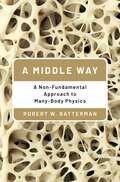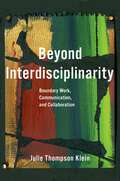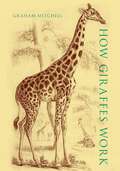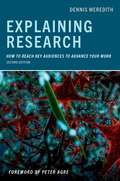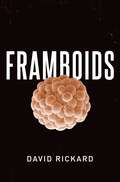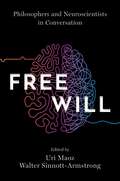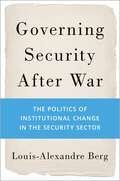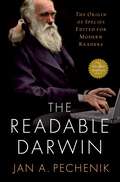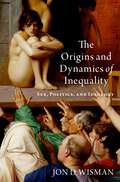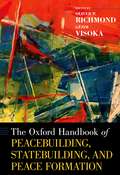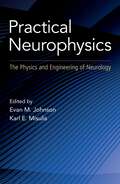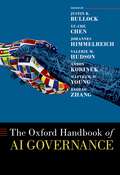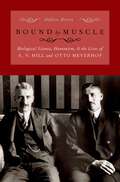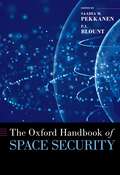- Table View
- List View
A Middle Way: A Non-Fundamental Approach to Many-Body Physics
by Robert W. BattermanRobert W. Batterman's monograph examines a ubiquitous methodology in physics and the science of materials that has virtually been ignored in the philosophical literature. This method focuses on mesoscale structures as a means for investigating complex many-body systems. It challenges foundational pictures of physics where the most important properties are taken to be found at lower, more fundamental scales. This so-called "hydrodynamic approach" has its origins in Einstein's pioneering work on Brownian motion. This work can be understood to be one of the first instances of "upscaling" or homogenization whereby values for effective continuum scale parameters can be theoretically determined. Einstein also provided the first statement of what came to be called the "Fluctuation-Dissipation" theorem. This theorem justifies the use of equilibrium statistical mechanics to study the nonequilibrium behaviors of many-body systems. Batterman focuses on the consequences of the Fluctuation-Dissipation theorem for a proper understanding of what can be considered natural parameters or natural kinds for studying behaviors of such systems. He challenges various claims that such natural, or joint carving, parameters are always to be found at the most fundamental level. Overall, Batterman argues for mesoscale first, middle-out approach to many questions concerning the relationships between fundamental theories and their phenomenological, continuum scale cousins.
Beyond Interdisciplinarity: Boundary Work, Communication, and Collaboration
by Julie Thompson KleinBeyond Interdisciplinarity examines the broadening meaning of core concept across academic disciplines and other forms of knowledge. In this book, Associate Editor of The Oxford Handbook of Interdisciplinarity and internationally recognized scholar Julie Thompson Klein depicts the heterogeneity and boundary work of inter- and trans-disciplinarity in a conceptual framework based on an ecology of spatializing practices in transaction spaces, including trading zones and communities of practice. The book includes both "crossdisciplinary" work (encompassing multi-, inter-, and trans-disciplinary forms) as well as "cross-sector" work (spanning disciplines, fields, professions, government and industry, and communities). The first section of the book defines and explains boundary work, discourses of interdisciplinarity, and the nature of interdisciplinary fields. In the second section, Klein examines dynamics of working across disciplines, including communication, collaboration, and learning with concrete examples and lessons from research projects and programs that transcend traditional fields. The closing chapter examines reasons for failure and success then presents gateways to literature and other resources. Throughout the book, Klein emphasizes the roles of contextualization and historical change while factoring in the shifting relationship of disciplinarity and interdisciplinarity, ascendancy of transdisciplinarity, and intersections with other constructs including Mode 2 knowledge production, convergence, team science, and postdisciplinarity. The conceptual framework she provides also includes the role of boundary objects, agents, and organizations in brokering differences and creating for platforms for change. Klein further explains why translation, interlanguage, and a communication boundary space are vital to achieving intersubjectivity and collective identity. They foster not only pragmatics of negotiation and integration but also reflexivity, transactivity, and co-production of knowledge with stakeholders beyond the academy. Rhetorics of holism and synthesis compete with instrumentalities of problem solving and transgressive critiques. However, typical warrants today include complexity, contextualization, collaboration, and socially-robust knowledge. Crossing boundaries remains complex, but this book guides readers through the density of pertinent literature while expanding understandings of crossdisciplinary and cross-sector work.
Beyond Interdisciplinarity: Boundary Work, Communication, and Collaboration
by Julie Thompson KleinBeyond Interdisciplinarity examines the broadening meaning of core concept across academic disciplines and other forms of knowledge. In this book, Associate Editor of The Oxford Handbook of Interdisciplinarity and internationally recognized scholar Julie Thompson Klein depicts the heterogeneity and boundary work of inter- and trans-disciplinarity in a conceptual framework based on an ecology of spatializing practices in transaction spaces, including trading zones and communities of practice. The book includes both "crossdisciplinary" work (encompassing multi-, inter-, and trans-disciplinary forms) as well as "cross-sector" work (spanning disciplines, fields, professions, government and industry, and communities). The first section of the book defines and explains boundary work, discourses of interdisciplinarity, and the nature of interdisciplinary fields. In the second section, Klein examines dynamics of working across disciplines, including communication, collaboration, and learning with concrete examples and lessons from research projects and programs that transcend traditional fields. The closing chapter examines reasons for failure and success then presents gateways to literature and other resources. Throughout the book, Klein emphasizes the roles of contextualization and historical change while factoring in the shifting relationship of disciplinarity and interdisciplinarity, ascendancy of transdisciplinarity, and intersections with other constructs including Mode 2 knowledge production, convergence, team science, and postdisciplinarity. The conceptual framework she provides also includes the role of boundary objects, agents, and organizations in brokering differences and creating for platforms for change. Klein further explains why translation, interlanguage, and a communication boundary space are vital to achieving intersubjectivity and collective identity. They foster not only pragmatics of negotiation and integration but also reflexivity, transactivity, and co-production of knowledge with stakeholders beyond the academy. Rhetorics of holism and synthesis compete with instrumentalities of problem solving and transgressive critiques. However, typical warrants today include complexity, contextualization, collaboration, and socially-robust knowledge. Crossing boundaries remains complex, but this book guides readers through the density of pertinent literature while expanding understandings of crossdisciplinary and cross-sector work.
How Giraffes Work
by Graham MitchellThere are few creatures more beautiful, aloof, and fascinating than giraffes. Their social and ecological impact has been documented by many researchers. However, the inner workings of extant giraffes are less well known. That is why Graham Mitchell decided to write How Giraffes Work: a comprehensive overview of the anatomy, physiology, and biochemistry--in short, the normal functions--of a free-living, wild animal in its natural environment. A zoologist, veterinarian, and physiologist, Mitchell explains how giraffes get through their day. Additionally, he takes readers through the evolution of their physical characteristics, such as their size, shape, and coat markings. His approach integrates history with the physiology, anatomy, biochemistry, behavior, evolution, genetics, ecology, climate science, and more. Each chapter follows the discovery and utility of a different characteristic of giraffes. Illustrated with over two hundred figures and diagrams, the book explains how giraffes might have evolved and survived over many millions of years as well as how our perception of them has changed throughout history. So, how do giraffes work? The answers lie in a story filled not only with the details of their internal working but also with the labors of the extraordinary scientists who have put so many pieces of this puzzle together.
How Giraffes Work
by Graham MitchellThere are few creatures more beautiful, aloof, and fascinating than giraffes. Their social and ecological impact has been documented by many researchers. However, the inner workings of extant giraffes are less well known. That is why Graham Mitchell decided to write How Giraffes Work: a comprehensive overview of the anatomy, physiology, and biochemistry--in short, the normal functions--of a free-living, wild animal in its natural environment. A zoologist, veterinarian, and physiologist, Mitchell explains how giraffes get through their day. Additionally, he takes readers through the evolution of their physical characteristics, such as their size, shape, and coat markings. His approach integrates history with the physiology, anatomy, biochemistry, behavior, evolution, genetics, ecology, climate science, and more. Each chapter follows the discovery and utility of a different characteristic of giraffes. Illustrated with over two hundred figures and diagrams, the book explains how giraffes might have evolved and survived over many millions of years as well as how our perception of them has changed throughout history. So, how do giraffes work? The answers lie in a story filled not only with the details of their internal working but also with the labors of the extraordinary scientists who have put so many pieces of this puzzle together.
Explaining Research: How to Reach Key Audiences to Advance Your Work
by Dennis MeredithExplaining Researchis the ultimate guide for scientists, engineers, and other professionals seeking to share their life's work effectively with important lay and scientific audiences. It offers a multitude of practical communication tools and techniques for writing, giving talks, creating visuals, using social media, and publicizing research advances. Career success depends on more than conducting incisive experiments and publishing papers in top journals. Researchers must also know how to explain their work to key audiences, such as colleagues, potential collaborators, officers in funding agencies and from foundations, donors, institutional leaders, corporate partners, students, legislators, journalists, and the general public. Explaining Research is the most comprehensive guide for science and engineering communication. In this new edition, leading research communicator Dennis Meredith provides readers with the practical tools and techniques scientists and engineers need to reach their audiences effectively. The updated and expanded chapters include a wealth of insights from leading science journalists and research communicators.
Explaining Research: How to Reach Key Audiences to Advance Your Work
by Dennis MeredithExplaining Researchis the ultimate guide for scientists, engineers, and other professionals seeking to share their life's work effectively with important lay and scientific audiences. It offers a multitude of practical communication tools and techniques for writing, giving talks, creating visuals, using social media, and publicizing research advances. Career success depends on more than conducting incisive experiments and publishing papers in top journals. Researchers must also know how to explain their work to key audiences, such as colleagues, potential collaborators, officers in funding agencies and from foundations, donors, institutional leaders, corporate partners, students, legislators, journalists, and the general public. Explaining Research is the most comprehensive guide for science and engineering communication. In this new edition, leading research communicator Dennis Meredith provides readers with the practical tools and techniques scientists and engineers need to reach their audiences effectively. The updated and expanded chapters include a wealth of insights from leading science journalists and research communicators.
Framboids
by David RickardFramboids may be the most astonishing and abundant natural features you've never heard of. These microscopic spherules of golden pyrite consist of thousands of even smaller microcrystals, often arranged in stunning geometric arrays. They are rarely more than twenty micrometers across, and often look like miniscule raspberries under the microscope. The formation of a framboid is the result of self-assembly of pyrite micro- and nano-crystals under the influence of surface forces. They can be found all around us in rocks of all ages and present-day sediments, soils, and natural waters. Our planet makes billions every second and has been doing so for most of recorded geologic time. As a result, there are more framboids on our planet than there are sand grains on Earth or stars in the observable universe. The microscopic size of framboids belies their importance to contemporary science. They help us better understand inorganic self-assembly and self-organization, and studying them illuminates Earth's evolutionary history. In this book, David Rickard explains what framboids are, how they are formed, and what we can learn from them. The book's thirteen chapters trace everything from their basic attributes and mineralogy to their biogeochemistry and paleoenvironmental significance. Rickard expands on the most updated research and recent developments in geology, chemistry, biology, materials science, biogeochemistry, mineralogy, and crystallography, making this a must-have guide for researchers.
Free Will: Philosophers and Neuroscientists in Conversation
What is free will? Can it exist in a determined universe? How can we determine who, if anyone, possesses it? Philosophers have debated the extent of human free will for millennia. In recent decades neuroscientists have joined the fray with questions of their own. Which neural mechanisms could enable conscious control of action? What are intentional actions? Do contemporary developments in neuroscience rule out free will or, instead, illuminate how it works? Over the past few years, neuroscientists and philosophers have increasingly come to understand that both fields can make substantive contributions to the free-will debate, so working together is the best path forward to understanding whether, when, and how our choices might be free This book contains thirty bidirectional exchanges between neuroscientists and philosophers that focus on the most critical questions in the neurophilosophy of free will. It mimics a lively, interdisciplinary conference, where experts answer questions and follow-up questions from the other field, helping each discipline to understand how the other thinks and works. Each chapter is concise and accessible to non-experts-free from disciplinary jargon and highly technical details-but also employs thorough and up-to-date research from experts in the field. The resulting collection should be useful to anyone who wants to get up to speed on the most fundamental issues in the rising field of the neurophilosophy of free will. It will interest experts from philosophy or neuroscience who want to learn about the other discipline, students in courses on a host of related topics, and lay readers who are fascinated by these profound issues.
Free Will: Philosophers and Neuroscientists in Conversation
by Uri Maoz and Walter Sinnott- ArmstrongWhat is free will? Can it exist in a determined universe? How can we determine who, if anyone, possesses it? Philosophers have debated the extent of human free will for millennia. In recent decades neuroscientists have joined the fray with questions of their own. Which neural mechanisms could enable conscious control of action? What are intentional actions? Do contemporary developments in neuroscience rule out free will or, instead, illuminate how it works? Over the past few years, neuroscientists and philosophers have increasingly come to understand that both fields can make substantive contributions to the free-will debate, so working together is the best path forward to understanding whether, when, and how our choices might be free This book contains thirty bidirectional exchanges between neuroscientists and philosophers that focus on the most critical questions in the neurophilosophy of free will. It mimics a lively, interdisciplinary conference, where experts answer questions and follow-up questions from the other field, helping each discipline to understand how the other thinks and works. Each chapter is concise and accessible to non-experts-free from disciplinary jargon and highly technical details-but also employs thorough and up-to-date research from experts in the field. The resulting collection should be useful to anyone who wants to get up to speed on the most fundamental issues in the rising field of the neurophilosophy of free will. It will interest experts from philosophy or neuroscience who want to learn about the other discipline, students in courses on a host of related topics, and lay readers who are fascinated by these profound issues.
Governing Security After War: The Politics of Institutional Change in the Security Sector
by Louis-Alexandre BergSecurity assistance has become the largest component of international peacebuilding and stabilization efforts, and a primary tool for responding to civil war and insurgency. Donors and peacekeepers not only train and equip military and police forces, they also seek to overhaul their structure, management, and oversight. Yet, we know little about why these efforts succeed or fail. Efforts to restructure security forces in Iraq, Libya, South Sudan, Timor-Leste, and the Democratic Republic of Congo ended amidst factional fighting. Similar efforts in Liberia, Sierra Leone, El Salvador, Mozambique, and Bosnia and Herzegovina helped to transform security forces and underpin peace. What accounts for the mixed outcomes of efforts to restructure security forces after civil war? What is the role of external involvement on these outcomes? In Governing Security After War, Louis-Alexandre Berg examines the political dimensions of security governance through systematic, cross-country comparison. Berg argues that the extent to which state policymakers adopt changes to the management and oversight of security forces depends on internal political dynamics, specifically the degree to which leaders need to consolidate power. The different political strategies leaders pursue, in turn, affect opportunities for external actors to influence institutional changes through means such as conditions on aid, norm diffusion, or day-to-day participation in decision-making. Drawing on an original dataset of security governance and field research in Liberia, Bosnia and Herzegovina, and Timor-Leste, as well as mini-case studies of Iraq, Afghanistan, South Sudan, and Somalia, Berg draws out novel implications that help explain the recurrence of civil war and the impact of foreign aid on peacebuilding. Moreover, Berg provides practical recommendations for navigating the political challenges of institutional change in conflict-affected countries. Ultimately, Governing Security After War seeks to explain the success and failure of international assistance in war-torn countries and sheds light on the politics of peacebuilding.
Governing Security After War: The Politics of Institutional Change in the Security Sector
by Louis-Alexandre BergSecurity assistance has become the largest component of international peacebuilding and stabilization efforts, and a primary tool for responding to civil war and insurgency. Donors and peacekeepers not only train and equip military and police forces, they also seek to overhaul their structure, management, and oversight. Yet, we know little about why these efforts succeed or fail. Efforts to restructure security forces in Iraq, Libya, South Sudan, Timor-Leste, and the Democratic Republic of Congo ended amidst factional fighting. Similar efforts in Liberia, Sierra Leone, El Salvador, Mozambique, and Bosnia and Herzegovina helped to transform security forces and underpin peace. What accounts for the mixed outcomes of efforts to restructure security forces after civil war? What is the role of external involvement on these outcomes? In Governing Security After War, Louis-Alexandre Berg examines the political dimensions of security governance through systematic, cross-country comparison. Berg argues that the extent to which state policymakers adopt changes to the management and oversight of security forces depends on internal political dynamics, specifically the degree to which leaders need to consolidate power. The different political strategies leaders pursue, in turn, affect opportunities for external actors to influence institutional changes through means such as conditions on aid, norm diffusion, or day-to-day participation in decision-making. Drawing on an original dataset of security governance and field research in Liberia, Bosnia and Herzegovina, and Timor-Leste, as well as mini-case studies of Iraq, Afghanistan, South Sudan, and Somalia, Berg draws out novel implications that help explain the recurrence of civil war and the impact of foreign aid on peacebuilding. Moreover, Berg provides practical recommendations for navigating the political challenges of institutional change in conflict-affected countries. Ultimately, Governing Security After War seeks to explain the success and failure of international assistance in war-torn countries and sheds light on the politics of peacebuilding.
The Readable Darwin: The Origin of Species Edited for Modern Readers
by Jan A. PechenikDarwin's The Origin of Species is one of the most influential books ever written. It is essential reading for anyone interested in biology, evolution, the natural world, or the history of scientific thought. However, the book can be difficult to follow. The sentences and paragraphs are lengthy, and Darwin often references people and ideas unfamiliar to contemporary readers. The Readable Darwin translates the sixth and final edition of Darwin's The Origin of Species (1872) into clear, engaging prose. Whereas the first edition of The Readable Darwin includes the first eight chapters of Darwin's book, this new edition presents all fifteen chapters of The Origin of Species and features over 100 illustrations. The Readable Darwin begins by discussing artificial selection, demonstrating that selection for new traits can indeed be made to occur, even within our lifetimes. It then presents evidence for natural selection derived from developmental traits and the geological record. Throughout, Pechenik painstakingly revises Darwin's prose. He breaks up long paragraphs, shortens and reorganizes sentences, and replaces weak verbs with strong ones. Footnotes clarify concepts, define terms, and identify the many historical figures Darwin mentions. The Origin of Species is a foundational work of scholarship in the biological sciences. It documents the remarkable diversity of life on earth and is a wonderful example of honest and logical scientific thinking. The Readable Darwin brings this groundbreaking book to life for readers of all backgrounds while remaining true to the original text.
The Readable Darwin: The Origin of Species Edited for Modern Readers
by Jan A. PechenikDarwin's The Origin of Species is one of the most influential books ever written. It is essential reading for anyone interested in biology, evolution, the natural world, or the history of scientific thought. However, the book can be difficult to follow. The sentences and paragraphs are lengthy, and Darwin often references people and ideas unfamiliar to contemporary readers. The Readable Darwin translates the sixth and final edition of Darwin's The Origin of Species (1872) into clear, engaging prose. Whereas the first edition of The Readable Darwin includes the first eight chapters of Darwin's book, this new edition presents all fifteen chapters of The Origin of Species and features over 100 illustrations. The Readable Darwin begins by discussing artificial selection, demonstrating that selection for new traits can indeed be made to occur, even within our lifetimes. It then presents evidence for natural selection derived from developmental traits and the geological record. Throughout, Pechenik painstakingly revises Darwin's prose. He breaks up long paragraphs, shortens and reorganizes sentences, and replaces weak verbs with strong ones. Footnotes clarify concepts, define terms, and identify the many historical figures Darwin mentions. The Origin of Species is a foundational work of scholarship in the biological sciences. It documents the remarkable diversity of life on earth and is a wonderful example of honest and logical scientific thinking. The Readable Darwin brings this groundbreaking book to life for readers of all backgrounds while remaining true to the original text.
The Origins and Dynamics of Inequality: Sex, Politics, and Ideology
by Jon D. WismanArgues that the struggle over income, wealth, status and privilege-inequality-has been the principal, defining issue in human history and provides a novel framework for understanding inequality today Whereas President Barack Obama declared inequality as the defining issue of our time, in The Origins and Dynamics of Inequality, Jon D. Wisman claims more: it is the defining issue of all human history. The struggle over inequality has been the underlying force driving human history's unfolding. Drawing on the dynamics of inequality, Wisman re-interprets economic history and society. Beyond according inequality the central role in history, this book is novel in two other respects: First, transcending the general failure of social scientists and historians to anchor their work in explicit theories of human behaviour, this book grounds the origins and dynamics of inequality in evolutionary psychology, or more specifically, Darwin's theory of sexual selection. Second, this book accords central importance to ideology in legitimating inequality, a role typically inadequately addressed by social scientists and historians. Because of the central role of inequality in history, inequality's explosion over the past forty years has not been an anomaly. It is a return to the political dynamics by which elites have, since the rise of the state, taken practically everything for themselves, leaving all others with little more than the means with which to survive. Due to elites' persuasive ideology, even after workers in advanced capitalist countries gained the franchise to become the overwhelming majority of voters, inequality continued to increase. Sweeping and provocative, Jon D. Wisman presents a fresh perspective on why economic inequality exists and how its dynamics have shaped human history.
The Origins and Dynamics of Inequality: Sex, Politics, and Ideology
by Jon D. WismanArgues that the struggle over income, wealth, status and privilege-inequality-has been the principal, defining issue in human history and provides a novel framework for understanding inequality today Whereas President Barack Obama declared inequality as the defining issue of our time, in The Origins and Dynamics of Inequality, Jon D. Wisman claims more: it is the defining issue of all human history. The struggle over inequality has been the underlying force driving human history's unfolding. Drawing on the dynamics of inequality, Wisman re-interprets economic history and society. Beyond according inequality the central role in history, this book is novel in two other respects: First, transcending the general failure of social scientists and historians to anchor their work in explicit theories of human behaviour, this book grounds the origins and dynamics of inequality in evolutionary psychology, or more specifically, Darwin's theory of sexual selection. Second, this book accords central importance to ideology in legitimating inequality, a role typically inadequately addressed by social scientists and historians. Because of the central role of inequality in history, inequality's explosion over the past forty years has not been an anomaly. It is a return to the political dynamics by which elites have, since the rise of the state, taken practically everything for themselves, leaving all others with little more than the means with which to survive. Due to elites' persuasive ideology, even after workers in advanced capitalist countries gained the franchise to become the overwhelming majority of voters, inequality continued to increase. Sweeping and provocative, Jon D. Wisman presents a fresh perspective on why economic inequality exists and how its dynamics have shaped human history.
The Oxford Handbook of Peacebuilding, Statebuilding, and Peace Formation (Oxford Handbooks)
by Oliver P. Richmond and Gëzim VisokaIn addition to being a major area of research within International Relations, peacebuilding and statebuilding is a major policy area within the UN and other international and regional organizations. It is also a concern of international financial institutions, including the World Bank, and a significant factor in the foreign and security policies of many established and emerging democracies. Peacebuilding and statebuilding are among the main approaches for preventing, managing, and mitigating global insecurities; dealing with the humanitarian consequences of civil wars; and expanding democracy and neoliberal economic regimes. Peace formation is a relatively new concept, addressing how local actors work in parallel to international and national projects, and helps shape the legitimacy of peace processes and state reform. The Oxford Handbook of Peacebuilding, Statebuilding, and Peace Formation serves as an essential guide to this vast intellectual and policy landscape. It offers a systematic overview of conceptual foundations, political implications, and tensions at the global, regional, and local levels, as well as key policies, practices, examples, and discourses underlining all segments of peacebuilding and statebuilding praxis. Approaching peacebuilding from disciplinary perspectives across the social sciences, the Handbook is organized around four major thematic sections. Section one explores how peacebuilding, statebuilding, and peace formation is conceived by different disciplines and IR approaches, thus offering an overview of the conceptual bedrock of major theories and approaches. Section two situates these approaches among other major global issues, including globalization, civil society, terrorism, and technology to illustrate their global, regional, and local resonance. Section three looks at key themes in the field, including peace agreements, democratization, security reform, human rights, environment, and culture. Finally, section four looks at key features of everyday and civil society peace formation processes, both in theory and in practice.
Practical Neurophysics: The Physics and Engineering of Neurology
Practical Neurophysics: The Physics and Engineering of Neurology explores and explains the physical foundations of neurology with a principal focus on the technologies that we use for diagnosis and management. The physics of biologic systems is also discussed, in the context of interfacing with our technologies and the mechanisms behind abnormalities. With sections on ultrasound, advanced laboratory tests, and neurotherapeutics, this is a unique book that focuses on the science and engineering rather than on disease processes. This book is intended to give the reader an appreciation of the mechanisms behind our technology and how humans and machines interface. The spectrum of presented information ranges from basic atomic physics to electronics to mechanisms of abnormalities on MRI and EEG. With this book, the reader should have a better understanding of the mechanisms of the technologies we use as well as an understanding of how normal and pathological functioning produces findings we can record.
Practical Neurophysics: The Physics and Engineering of Neurology
by Evan M. Johnson and Karl E. MisulisPractical Neurophysics: The Physics and Engineering of Neurology explores and explains the physical foundations of neurology with a principal focus on the technologies that we use for diagnosis and management. The physics of biologic systems is also discussed, in the context of interfacing with our technologies and the mechanisms behind abnormalities. With sections on ultrasound, advanced laboratory tests, and neurotherapeutics, this is a unique book that focuses on the science and engineering rather than on disease processes. This book is intended to give the reader an appreciation of the mechanisms behind our technology and how humans and machines interface. The spectrum of presented information ranges from basic atomic physics to electronics to mechanisms of abnormalities on MRI and EEG. With this book, the reader should have a better understanding of the mechanisms of the technologies we use as well as an understanding of how normal and pathological functioning produces findings we can record.
The Oxford Handbook of AI Governance (Oxford Handbooks)
As the capabilities of Artificial Intelligence (AI) have increased over recent years, so have the challenges of how to govern its usage. Consequently, prominent stakeholders across academia, government, industry, and civil society have called for states to devise and deploy principles, innovative policies, and best practices to regulate and oversee these increasingly powerful AI tools. Developing a robust AI governance system requires extensive collective efforts throughout the world. It also raises old questions of politics, democracy, and administration, but with the new challenges posed by AI's growing influence on markets, governing structures, international relations, healthcare, science, and political activism. The Oxford Handbook of AI Governance delineates the scope of these issues and addresses the key questions of AI governance. Across forty-nine chapters, organized in nine major sections, the Handbook covers the theoretical and ethical foundations of AI governance, different frameworks for developing a governance structure for AI, practical perspectives on AI governance in different policy domains, economic analyses of AI governance, and concrete lessons about the impact of AI governance domestically and internationally. Chapter authors come from a wide set of disciplines, areas of study, and cultural backgrounds, providing a global perspective on AI governance.
The Oxford Handbook of AI Governance (Oxford Handbooks)
by Justin B. Bullock, Yu-Che Chen, Johannes Himmelreich, Valerie M. Hudson, Anton Korinek, Matthew M. Young and Baobao ZhangAs the capabilities of Artificial Intelligence (AI) have increased over recent years, so have the challenges of how to govern its usage. Consequently, prominent stakeholders across academia, government, industry, and civil society have called for states to devise and deploy principles, innovative policies, and best practices to regulate and oversee these increasingly powerful AI tools. Developing a robust AI governance system requires extensive collective efforts throughout the world. It also raises old questions of politics, democracy, and administration, but with the new challenges posed by AI's growing influence on markets, governing structures, international relations, healthcare, science, and political activism. The Oxford Handbook of AI Governance delineates the scope of these issues and addresses the key questions of AI governance. Across forty-nine chapters, organized in nine major sections, the Handbook covers the theoretical and ethical foundations of AI governance, different frameworks for developing a governance structure for AI, practical perspectives on AI governance in different policy domains, economic analyses of AI governance, and concrete lessons about the impact of AI governance domestically and internationally. Chapter authors come from a wide set of disciplines, areas of study, and cultural backgrounds, providing a global perspective on AI governance.
Bound by Muscle: Biological Science, Humanism, and the Lives of A. V. Hill and Otto Meyerhof
by Andrew BrownIn Bound by Muscle, Andrew Brown details the lives and achievements of two physiologists, Archibald Vivian Hill (1886-1977) and Otto Fritz Meyerhof (1884-1951). Hill and Meyerhof shared the 1922 Nobel Prize in Physiology or Medicine for discoveries related to metabolic changes underlying muscle activity. Bound by Muscle describes how Hill and Meyerhof's lives and careers intersected and diverged and how their work changed the course of biological science. Bound by Muscle is organized chronologically. The first four chapters consider Hill and Meyerhof's childhoods and early careers; subsequent chapters address the Nobel Prize nomination and award and how their lives were affected by the World Wars. Bound by Muscle details Hill and Meyerhof's scientific breakthroughs and professional accomplishments. The book also examines the historical context that shaped their work and how the two men differed. Hill embodied the pragmatic style of British science. He became an outspoken critic of fascism as well as an effective humanitarian. As a senior scientist, he played major roles in preparing Great Britain for World War II. In contrast, Meyerhof was shy and philosophical. A non-observant Jew, he was reluctant to leave his superb laboratory in Heidelberg as the Nazi threat became apparent. His dramatic eventual escape is described in detail for the first time. Throughout, Bound by Muscle reflects on how individual differences and historical events have shaped the trajectory of science.
Bound by Muscle: Biological Science, Humanism, and the Lives of A. V. Hill and Otto Meyerhof
by Andrew BrownIn Bound by Muscle, Andrew Brown details the lives and achievements of two physiologists, Archibald Vivian Hill (1886-1977) and Otto Fritz Meyerhof (1884-1951). Hill and Meyerhof shared the 1922 Nobel Prize in Physiology or Medicine for discoveries related to metabolic changes underlying muscle activity. Bound by Muscle describes how Hill and Meyerhof's lives and careers intersected and diverged and how their work changed the course of biological science. Bound by Muscle is organized chronologically. The first four chapters consider Hill and Meyerhof's childhoods and early careers; subsequent chapters address the Nobel Prize nomination and award and how their lives were affected by the World Wars. Bound by Muscle details Hill and Meyerhof's scientific breakthroughs and professional accomplishments. The book also examines the historical context that shaped their work and how the two men differed. Hill embodied the pragmatic style of British science. He became an outspoken critic of fascism as well as an effective humanitarian. As a senior scientist, he played major roles in preparing Great Britain for World War II. In contrast, Meyerhof was shy and philosophical. A non-observant Jew, he was reluctant to leave his superb laboratory in Heidelberg as the Nazi threat became apparent. His dramatic eventual escape is described in detail for the first time. Throughout, Bound by Muscle reflects on how individual differences and historical events have shaped the trajectory of science.
The Oxford Handbook of Space Security (Oxford Handbooks)
by Saadia M. PekkanenSpace security is a complex assemblage of societal risks and benefits that result from space-based capabilities and is currently in a period of transformation as innovative processes are rapidly changing the underlying assumptions about stability in the space domain. New space-based technologies are emerging at an accelerating rate, and both established and emerging states are actively and openly pursuing weapons to negate other states' space capabilities. Many states have set up dedicated military space units in order to preemptively counter such threats. In addition, a number of major private companies with a transnational presence are also investing heavily in extraterrestrially-based technology. The Oxford Handbook of Space Security focuses on the interaction between space technology and international and national security processes from an international relations (IR) theory perspective. Saadia M. Pekkanen and P.J. Blount have gathered a group of key scholars who bring a range of analytical and theoretical IR perspectives to assessing space security. The volume theorizes the development and governance of space security and analyzes the specific pressure points currently challenging that regime. Further, it builds an analytically-eclectic understanding of space security, infused with the theory and practice of IR and advances analysis of key states and regions as well as specific capabilities. Space security is currently in a period of great transition as new technologies are emerging and states openly pursue counterspace capabilities. Bringing together scholarship from a group of leading experts, this volume explains how these contemporary changes will affect future security in, from, and through space. Applying lessons from international relations theory and practice and drawing from a range of social science subfields, the Handbook is a definitive work for scholars who study the topic of space security.
The Oxford Handbook of Space Security (Oxford Handbooks)
by Saadia M. PekkanenSpace security is a complex assemblage of societal risks and benefits that result from space-based capabilities and is currently in a period of transformation as innovative processes are rapidly changing the underlying assumptions about stability in the space domain. New space-based technologies are emerging at an accelerating rate, and both established and emerging states are actively and openly pursuing weapons to negate other states' space capabilities. Many states have set up dedicated military space units in order to preemptively counter such threats. In addition, a number of major private companies with a transnational presence are also investing heavily in extraterrestrially-based technology. The Oxford Handbook of Space Security focuses on the interaction between space technology and international and national security processes from an international relations (IR) theory perspective. Saadia M. Pekkanen and P.J. Blount have gathered a group of key scholars who bring a range of analytical and theoretical IR perspectives to assessing space security. The volume theorizes the development and governance of space security and analyzes the specific pressure points currently challenging that regime. Further, it builds an analytically-eclectic understanding of space security, infused with the theory and practice of IR and advances analysis of key states and regions as well as specific capabilities. Space security is currently in a period of great transition as new technologies are emerging and states openly pursue counterspace capabilities. Bringing together scholarship from a group of leading experts, this volume explains how these contemporary changes will affect future security in, from, and through space. Applying lessons from international relations theory and practice and drawing from a range of social science subfields, the Handbook is a definitive work for scholars who study the topic of space security.
